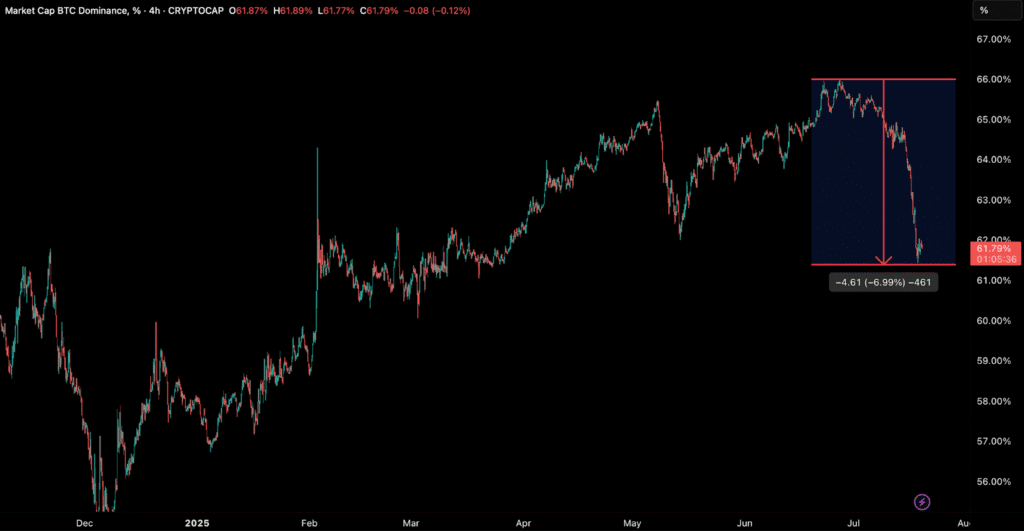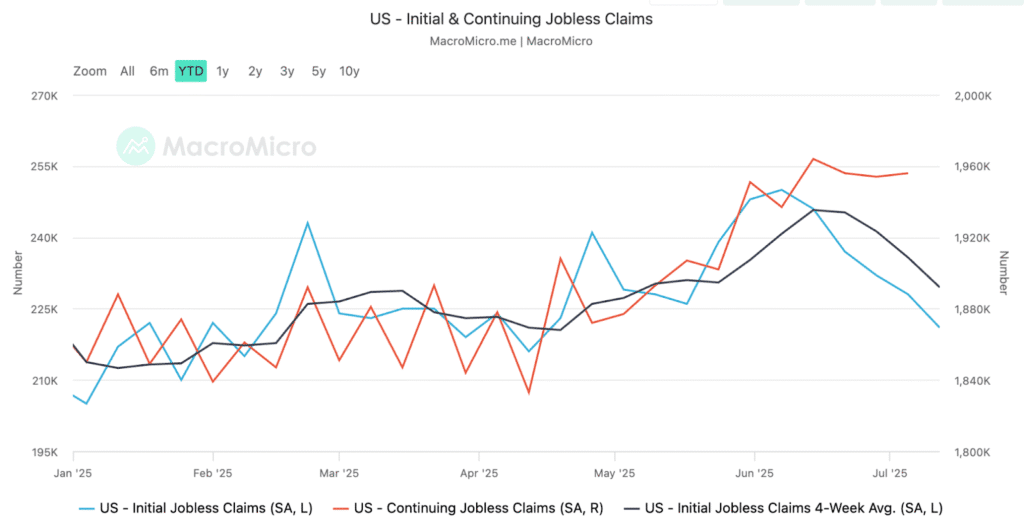Bitcoin dominance declines as BTC reached a new all-time high, yet its leadership in the cryptocurrency market is showing a clear downward trend. The recent Bitfinex Alpha report indicates that while Bitcoin remains near its peak, altcoins such as Ethereum (ETH) and XRP are experiencing an aggressive surge.
This Bitcoin dominance decline shows a shift towards more vulnerable, yet more profitable, investments and a larger market rotation towards altcoins.
The price of Bitcoin surged to $123,120, representing a 65.3% rebound from the April low. As Bitcoin halted, however, the altcoins started gaining. Ethereum increased by 19.45%, while XRP rose by 21.4%.
The momentum change helped to push the Bitcoin dominance decline by 6.9%, which is the largest decline since December 2023. The shift in market interest has led to an increase in altcoin activity, pointing to the possibility of rotation into assets with higher beta, which is typical in mid-cycle expansion states.
Bitcoin Dominance Decline
Bitcoin dominance decline seen as altcoins take the lead. The latest data reveals that the market index, excluding stablecoins and the top ten assets, surged by 35%, adding around $85 billion to the total market capitalization.

Solana (SOL) also saw substantial growth, attracting liquidity away from Bitcoin as traders looked for higher upside. This increased participation from altcoins highlights a more diverse and dynamic market, reflecting growing investor confidence in assets beyond Bitcoin.
Mid-Cycle Expansion: Higher-Risk Altcoins Gain Traction
Bitcoin dominance decline indicates a key market rotation. During mid-cycle expansions, investors typically become more willing to take risks, moving from Bitcoin into altcoins that offer higher growth potential.
This shift is evident with large-cap altcoins like Ethereum and XRP outperforming Bitcoin for the first time in months. The rotation into altcoins is a hallmark of a maturing market, where risk tolerance increases, and broader market participation occurs.
| Month | Min. Price | Avg. Price | Max. Price | Potential ROI |
|---|---|---|---|---|
| Jul 2025 | $ 119,349 | $ 129,216 | $ 140,814 | 19.37% |
| Aug 2025 | $ 115,624 | $ 126,995 | $ 142,500 | 20.80% |
| Sep 2025 | $ 104,788 | $ 108,017 | $ 115,849 | 1.80% |
| Oct 2025 | $ 105,286 | $ 106,099 | $ 107,306 | 9.04% |
| Nov 2025 | $ 102,107 | $ 103,736 | $ 106,910 | 9.37% |
| Dec 2025 | $ 102,294 | $ 102,470 | $ 102,655 | 12.98% |
Despite the Bitcoin dominance decline, BTC remains structurally strong. It continues to trade well above the realized cost basis of 95% of holders, which suggests most Bitcoin holders are still in profit.
This is a common feature of late-stage bullish phases, where profit-taking by short-term holders intensifies. Long-term holders are beginning to distribute coins, signaling that the market is maturing. However, this also introduces fragility, especially if momentum fades.
Resistance Levels and Market Outlook
Bitcoin recently retreated to $115,820, having tested the $120,000 mark, one of its main resistance zones. Bitcoin will require having the upcoming critical resistance level at $136,000 to sustain its trend, which is historically connected with overbought situations.
To maintain this impetus, new institutional inflows or other macroeconomic fundamentals would be required. Bitcoin is still resilient, but the spotlight now falls on altcoins, and their recent rally proved an indication of a market leader change.
Macro Economic Factors Impacting Crypto
The macroeconomic environment is also influencing the cryptocurrency market. Rising tariff-driven inflation in the U.S. has increased the prices of consumer goods, including appliances and apparel.
Despite inflationary pressures, U.S. retail sales increased by 0.6% in June, driven by auto sales and preemptive consumer buying ahead of expected tariff hikes. Although inflation remains a concern, its impact on Bitcoin and altcoins remains uncertain, with market participants reacting cautiously.

Institutional Adoption of Bitcoin
On the institutional front, Bitcoin adoption is growing. Strategy (formerly MicroStrategy) now holds over 600,000 BTC, valued at over $73 billion. This growing institutional interest suggests that Bitcoin’s role as a store of value is becoming more widely recognized.
Meanwhile, regulatory pressure is increasing in some countries. Hungary has imposed strict penalties on unlicensed cryptocurrency trading, while Kazakhstan is exploring the allocation of cryptocurrencies in its sovereign reserves. These regulatory moves reflect the increasing importance of cryptocurrencies on the global stage.
Conclusion
Bitcoin dominance decline is the issue that changes the situation in the financial world of cryptocurrencies radically. Although structurally, Bitcoin has not been weakened, the emergence of altcoins implies a more diversified market.
Ethereum, XRP, and Solana are front-runners of this move, demonstrating that the market is changing as it is not only Bitcoin anymore. The trend to rotate into higher-beta assets is probably destined to continue as the crypto market matures, and it can become the start of the new age of a crypto market evolution.
Stay up to date with expert analysis and price predictions by visiting our crypto news platform.
Summary
Altcoins have overwhelmed the Bitcoin dominance decline as Ethereum and XRP rose and this is another market rotation point. This change is characteristic of mid-cycle expansions in which investors shift to more risky and more rewarding assets.
Nonetheless, Bitcoin is solid in its structure as it is being traded many times above the cost basis of most holders despite Bitcoin dominance decline. Nevertheless, this is being circulated by more genetic owners, which points to the maturity of the market, which could have weaknesses.
Yet, with the consolidation of BTC, altcoins poured in to the front and displayed a more diversified and dynamic cryptocurrency marketplace.
Frequently Asked Questions (FAQ)
1. What is Bitcoin dominance?
Bitcoin dominance refers to Bitcoin’s share of the total cryptocurrency market cap. It is a key indicator of Bitcoin’s relative strength compared to other cryptocurrencies.
2. Why did Bitcoin dominance decline?
Bitcoin dominance decline as altcoins like Ethereum, XRP, and Solana surged, reflecting a shift towards higher-risk investments.
3. How does Bitcoin’s dominance affect the market?
A decline in Bitcoin dominance suggests a broader market rotation, with investors diversifying into altcoins for greater returns.
4. Will Bitcoin regain its dominance?
Bitcoin could regain dominance if it continues to rally, but altcoins are gaining traction, signaling a more balanced market.
Appendix: Glossary of Key Terms
Bitcoin Dominance – The percentage of Bitcoin’s market capitalization relative to the total cryptocurrency market, indicating its market share and influence.
Altcoins – Cryptocurrencies other than Bitcoin, often considered riskier but with higher potential returns.
Market Rotation – The movement of capital from one asset class to another, typically from Bitcoin to altcoins in mid-cycle expansions.
Ethereum (ETH) – A leading cryptocurrency that introduced smart contracts and decentralized applications.
XRP – A digital asset primarily used for fast and low-cost international money transfers, often associated with the Ripple network.
Solana (SOL) – A high-performance blockchain known for its fast transaction speeds and low costs, gaining popularity in the altcoin space.
Consolidation Phase – A period where an asset’s price stabilizes after significant gains, often marked by sideways price movement.
References
CryptoSlate – cryptoslate.com
CoinCentral – coincentral.com
Bitfinex – bitfinex.com





























